From DIANE to CAINs in the Echo
The A-6E was the most capable version of the Intruder. A-6Es were first delivered to VA-42 Green Pawns in 1970 and first deployed by VA-85 Black Falcons with CVW-17 aboard USS Forrestal (CVA-59) on December 9th 1971. The E model Intruder incorporated improvements to the majority of the mission systems and uprated J52-P8B engines. The two radars in previous variants were incorporated into a single multi-mode radar and much of the 1950s and 1960s era circuitry was updated to more modern and reliable equipment. The navigation system of the A-6E was also upgraded to the more accurate Carrier Airborne Inertial Navigation System (CAINS).
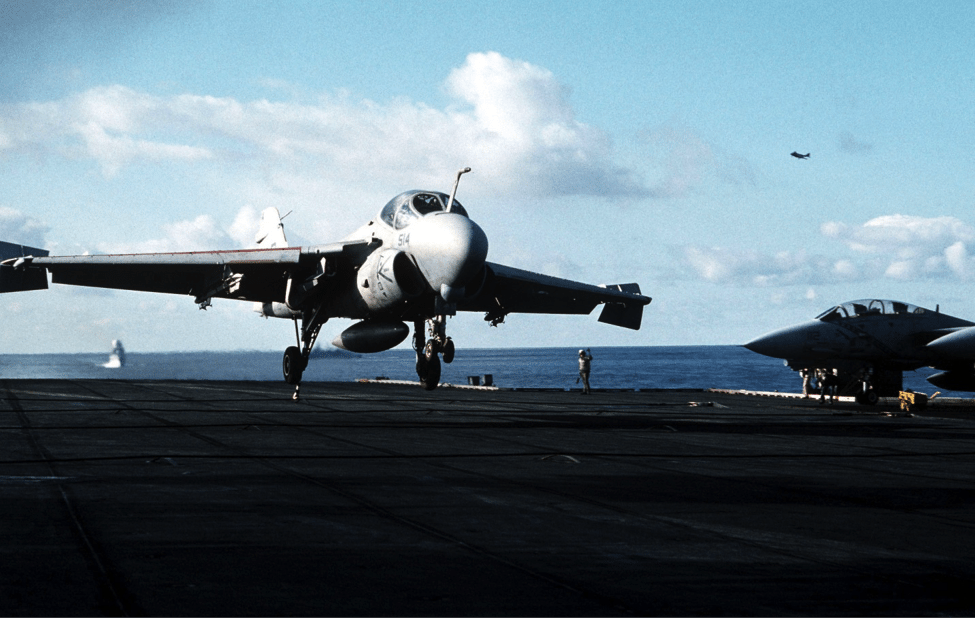
Keeping the Intruder On Target
The A-6E underwent a number of incremental upgrades over the next 20 years. The Target Recognition Attack Multi-sensor (TRAM) was added beginning in 1974 and by the mid-1980s all fleet Intruders had been updated to the A-6E TRAM variant. TRAM included the basic functionality of the A-6C’s TRIM sensor package but also incorporated the laser designator required for delivery of precision laser-guided munitions. The fleet Intruders were upgraded with improved systems when new munitions or required capabilities dictated.
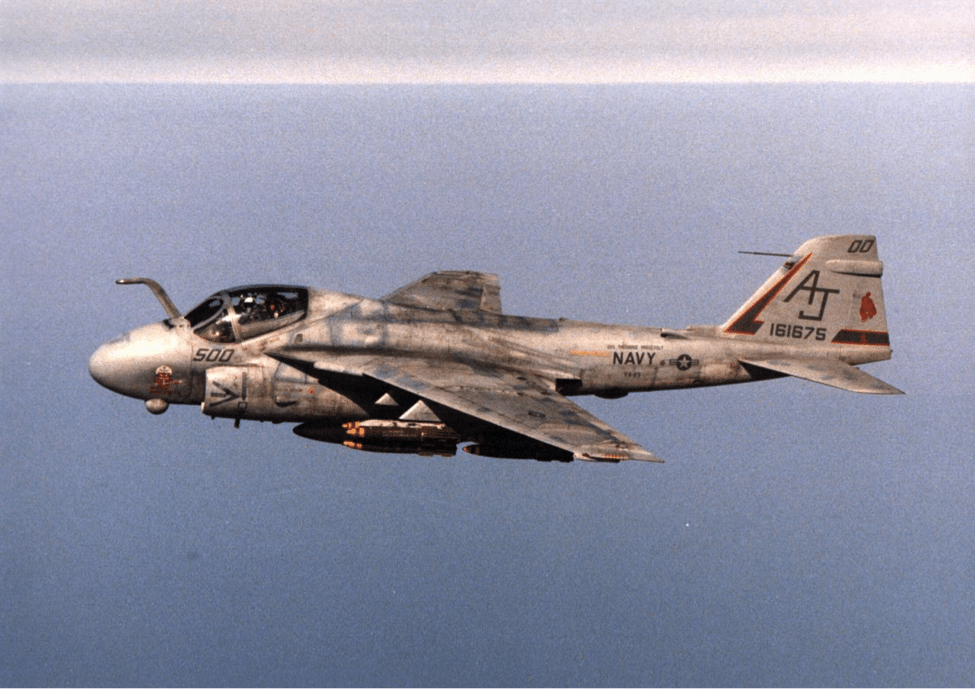
New Wings for the Old Warrior
Roughly 85 percent of the A-6Es also received new graphite/epoxy/titanium/aluminum composite wings after the original wings began to show signs of fatigue. Production of the Intruder at Grumman had continued, albeit at a low four or five aircraft per year rate, through the 1970s and 1980s. But in 1990 the Navy made the decision to end production of the Intruder. The final production order placed by the Navy with Grumman was for 20 A-6E TRAM Intruders equipped with the new composite wings, which were all delivered by 1993. A-6E model production was 445 airframes. 240 of them were reworked from earlier A-6As, A-6Bs, and A-6Cs.

When You Want the Most Capable Jet
Intruders were involved in every Navy conflict during the jet’s service life. After Vietnam, during the Mayaguez Incident VA-95 Green Lizards A-6As with CVW-15 aboard USS Coral Sea (CVA-43) flew missions in support of the extraction of US Marines from Koh Tang Island. During Operation Urgent Fury in Grenada on October 25th 1983 VA-176 Thunderbolts A-6Es with CVW-6 aboard USS Independence (CVA-62) flew missions in support of US Army Rangers and US Navy SEALs in contact with enemy troops. This was the combat debut of the A-6E.
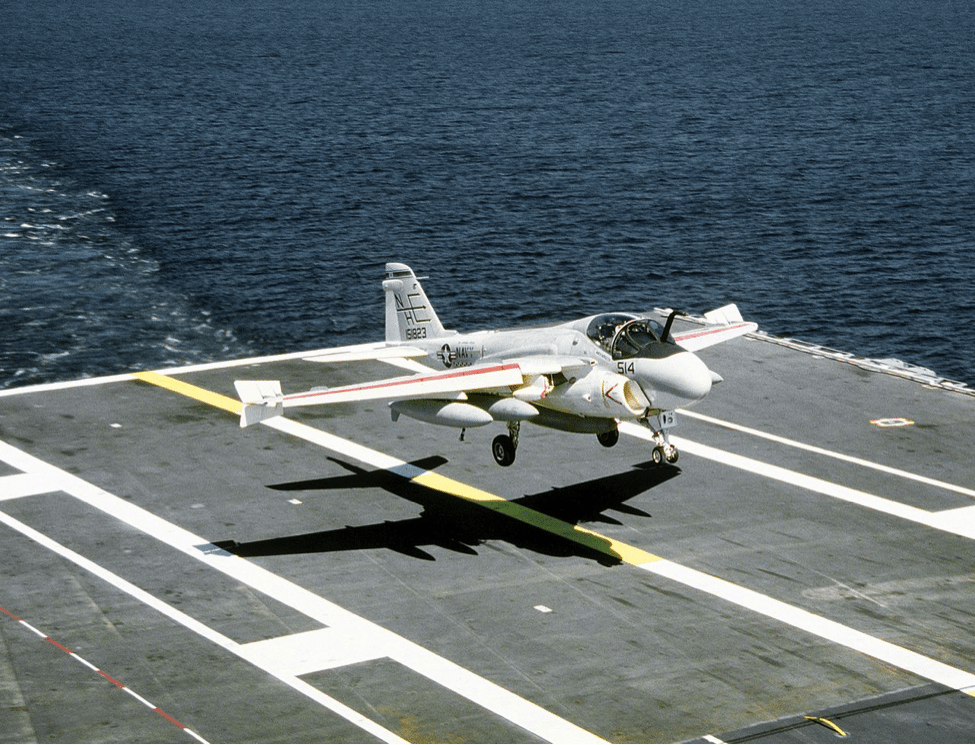
Precision Strike Always On Call
During the Lebanon Crisis on December 4th 1983, a VA-85 Black Falcons A-6E with CVW-3 aboard USS John F Kennedy (CVA-67) was shot down by a Syrian SAM. Navy Lieutenants Mark Lange and Robert Goodman both ejected from their stricken Intruder. Lange died of his injuries on the ground. Goodman survived and was made a Syrian prisoner until he was released on January 3rd 1984. During Operation Prairie Fire against Libya on March 24th 1986 VA-85 Black Falcons A-6Es with CVW-17 aboard USS Saratoga (CVA-60), VA-34 Blue Blasters A-6Es with CVW-1 aboard USS America (CVA-66), and VA-55 Warhorses A-6Es with CVW-13 aboard USS Coral Sea (CVA-43) destroyed or damaged several Libyan Navy ships and craft and multiple SAM sites.

Carrying a Big Stick
During Operation Eldorado Canyon on April 15th 1986 VA-34 Blue Blasters A-6Es with CVW-1 aboard USS America (CVA-66) and VA-55 Warhorses A-6Es with CVW-13 aboard USS Coral Sea (CVA-43) flew attack missions against Libyan military targets as retaliation for the Libyan bombing of a German nightclub which killed two US servicemen and wounded 50 more. The Intruders destroyed 20 aircraft and multiple radars on the ground in Benghazi, Libya. During Operation Praying Mantis on April 18th 1988 VA-95 Green Lizards A-6Es with CVW-11 aboard USS Enterprise (CVN-65) attacked and sank or damaged several Iranian Naval ships and craft. Intruders also kept vital gas airborne for long-duration patrol missions over hostile platforms and facilities in the Gulf.

Upgrading the Reserves
Naval Reserve A-7 Corsair II light attack squadron VA-304 Firebirds at NAS Alameda in California was reconstituted as a medium attack squadron and re-equipped with A-6Es in 1990. Naval Reserve A-7 Corsair II light attack squadron VA-205 Green Falcons at NAS Atlanta in Georgia was reconstituted as a medium attack squadron and re-equipped with A-6Es in 1990. It seemed like they wanted to keep the Intruders around for a while longer.
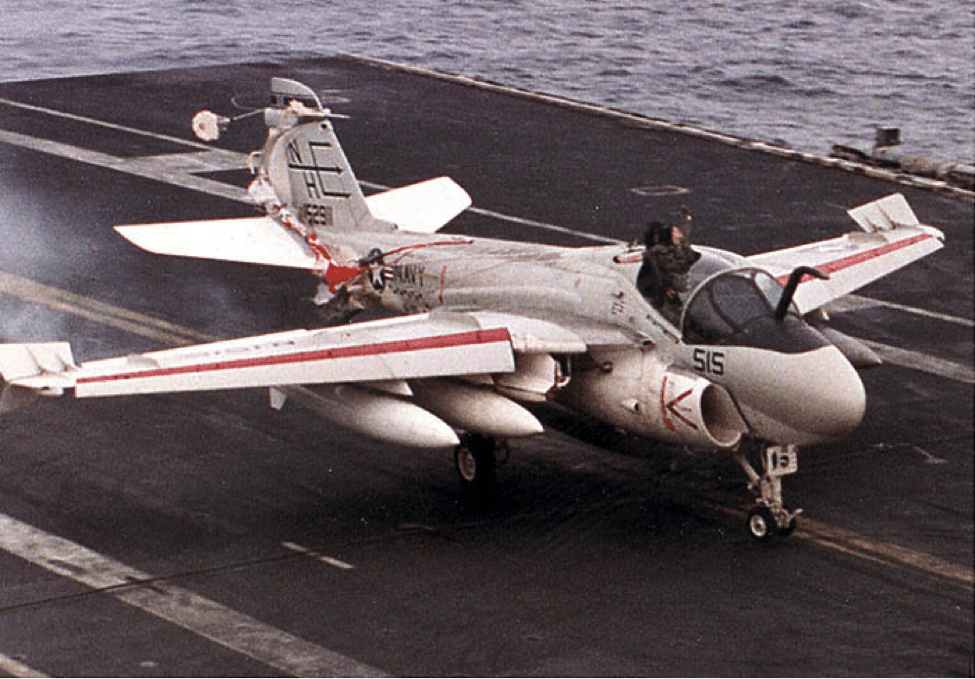
Ride in the Rumble Seat
One particularly hairy situation developed when Lieutenant Keith Gallagher, a VA-95 Green Lizards KA-6D BN, was partially ejected from his jet during the first deployment of USS Abraham Lincoln (CVN-72). Pilot Lieutenant Mark Baden was maneuvering to free what was thought to be a stuck float valve when Gallagher’s Martin-Baker ejection seat partially fired. After a few tense minutes and some seriously frenzied aircraft movement on the boat, which was not spotted for recovery, Baden brought the jet and his BN aboard on the first pass within six minutes. Gallagher’s parachute had released and wrapped itself around the Texaco’s tail surfaces. The only thing keeping Gallagher in the jet were his parachute risers pulling him back against his ejection seat! Gallagher recovered fully and was back flying again six months later.

The Intruder Goes to War For the Last Time
Intruders flew more than 4700 sorties and prosecuted 85 percent of all the laser designations and laser-guided bombs (LGBs) dropped on targets during Operation Desert Storm. Navy Intruder deployments during Shield and Storm were VA-35 Black Panthers with CVW-17 aboard USS Saratoga (CVA-60), VA-75 Sunday Punchers with CVW-3 aboard USS John F Kennedy (CVA-67), VA-115 Eagles and VA-185 Nighthawks with CVW-5 aboard USS Midway (CVA-41), VA-145 Swordsmen and VA-155 Silver Foxes with CVW-2 aboard USS Ranger (CVA-61), VA-85 Black Falcons with CVW-1 aboard USS America (CVA-66), and VA-36 Roadrunners and VA-65 Tigers with CVW-8 aboard USS Theodore Roosevelt (CVN-71). Marine A-6Es also operated from Shaikh Isa Air Base in Bahrain. A total of three Intruders were shot down during Operations Desert Shield and Desert Storm.
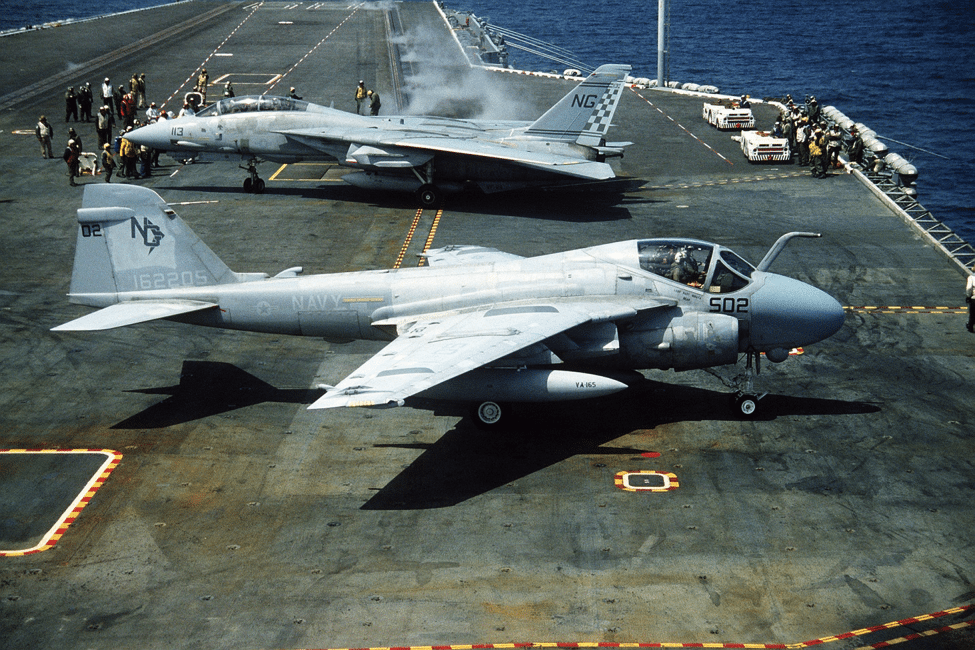
The Best Available But Still Out of a Job
After the Gulf War, Intruders flew no-fly zone enforcement missions and supported Operation Restore Hope in Somalia. The final operational use of Intruders was over Bosnia in 1994. Intruders were in production with new wings, and older airframes were getting new wings, during and after the Gulf War but the Office of the Secretary of Defense decided to reduce the number of different aircraft in Navy carrier air wings and Marine aircraft groups. The last Marine Intruder operators were VMA(AW)-332 Moonlighters who retired their A-6Es on April 28th 1993. The last Navy Intruder operators to fly off a carrier deck were VA-75 Sunday Punchers, who flew their retro paint job Intruders from the deck of the USS Enterprise (CVN-65) on December 19th 1996 and into retirement in 1997. There are 47 relatively young A-6Es in storage at AMARG at time of this article.

Here are a few things you might not know about Intruders:
- When the A-6 was retired, several airframes that were in limbo waiting for new wings at the Northrop Grumman facility at St. Augustine in Florida were sunk off the Florida coast to form an artificial reef named “Intruder Reef.”
- In the movie Flight of the Intruder (Paramount 1991), Commander Camparelli’s crash-landed Intruder nose section is actually that of a partially scrapped EA-6A. VA-165 Boomers A-6Es were used for the inflight, flight deck, and hangar deck scenes in the film. The film was shot aboard the USS Independence (CVA-62) and at Pearl Harbor.
- The movie was based on the book Flight of the Intruder by writer and former A-6 pilot Stephen Coonts. Coonts deployed to Southeast Asia twice between 1972 and 1975 as part of CVW-14 aboard USS Enterprise CVN-65. Coonts flew with VA-196 Main Battery, the squadron which VA-165 was simulating in the film. Coonts has penned a series of books based on the Intruder pilot character Jake Grafton.

- Grumman removed the BN from the A-6 and lightened the design to compete for a single-seat light attack aircraft proposal intended to provide a replacement for the Douglas A-4 Skyhawk. The contract was eventually won by the Vought A-7 Corsair II.
- Because KA-6D Texaco tankers could not recover aboard an aircraft carrier if the refueling hose could not be reeled in, an explosive cutter system was integrated into the system to detach the hose if required.
- The lights mounted on the leading edge of the vertical stabilizer were red on attack versions of the Intruder, but they were green on the KA-6D tanker version.


7. Here is the seventh thing you didn’t know about the mighty Intruder.
I am Joe Schutte. I am the final checker/ troubleshooter on the port side of the VA-75 A/C 514 aboard CVN65 December 19, 1997.
Was a flight deck trouble shooter with VA 165 on CVA 66 the first squadron to have A6C thank you for your article. Go Boomers.
Thank you for sharing. My tour with VA165 was in 1967, last of three west pac’s was in 1970.
Joe, I believe I have heard your name before….I am retired (USAF) MSgt Earl B. Pate Jr. My older 1/2 brother was LtCmdr Carroll Owen Crain, A3-B Skywarrior pilot, MIA/KIA, Mar 8, 1967. I have discussed the circumstances of his mission, as well as, the aircraft’s disappearance with other crew members who were present on board ship USS Kitty-Hawk. If you knew Carroll, or have some second, or first-hand knowledge of these missions, I would like to hear from you ! Even if you may not, I would still like to speak with you.
Sincerely,
Earl
(719- 550-1498 }
E-Mail [ pate5027@comcast.net ]
Take Care
I served with VMA( AW) 332 from 1973 to 1977, as a 6013 PC
We change the tail design from pokadots / top hats while in Japan.
It was interesting to read this article…thanks for sharing..!
Cpl. DV PASK
I absolutely loved the A6 Intruder having served aboard the carrier Kitty Hawk CVA63 from ’71 to ’73. Such a workhorse of an aircraft. I believe that the airframe of the A6 was made from a single chunk of aluminum thus giving it superior strength 💪 to carry as much of a payload as it did.
Marine A6 squadron VMA(Aw)224 was stationed on the USS Coral Sea 1972 to 1973
As of March 2020, all the A-6 Intruders in storage at the AMARG in Tucson AZ(Davis Monthan Boneyard) have gone to the grinder. I watched them being towed off to the scrapper just off base. There are two left on Display Row for now, but who knows for how long. Also for you seasoned EA-6B Prowler guys like myself, their days in storage are numbered too since none are flying anymore…VMAQ2 delivered the last 3 a few months ago. End of an era for two great aircraft, it’s over and the “fat lady has sung”. I think any of us who flew or maintained these great jets should feel a great sense of pride for what we accomplished in protectong this great nation of ours..fair winds and following seas…
The mighty double ugly…I really feel like the Vietnam war would have turned out much differently if she wasnt such a great all weather intruder!! R.I.P.
I have nothing but respect for you Joe and every man and woman who served in our armed services!! God bless America and you as well!!
VMA(as)224 was deployed on the USS Coral Sea 1971 1972 . So this article is in error stating that the Marines we we entirely land based. This squadron participated in Linebacker 1 & 2 and the mining of Hiphong harbor.
VA-34 Blue Blaster power plant mechanic from July 78 to Jan 82 . 2 deployments to the Mediterranean onboard the USS JOHN F KENNEDY CV-67 . I was the crazy guy in the shop during the 2nd deployment as I volunteered to be the night shift trouble shooter . On that deployment our squadron set a A-6 community record of flying over 60 straight sorties 100 % mission capable !
Number 8. I had the honor of qualifying in the A-6B TIAS (target identification acquisition system) only 5 of these were produced. The aircraft was identifiable by the small disk shape antennas on the nose. The system was passive and could program the standard arm missile we carried. Very accurate in identifying specific ships, their radars and so forth. Qualification Crews were identified in the squadron and the TIAS aircraft were transferred to the relieving carrier air wing and squadron.